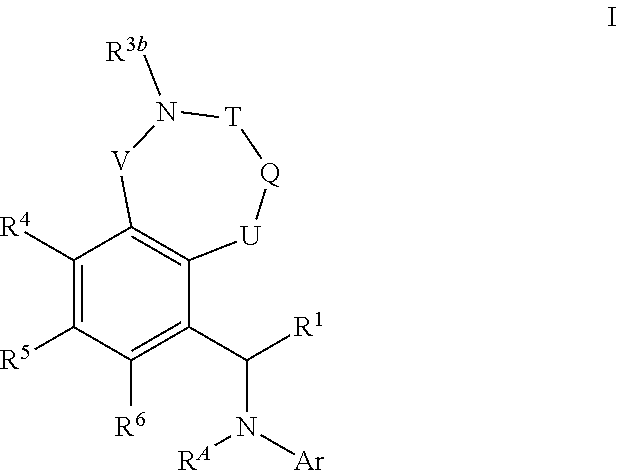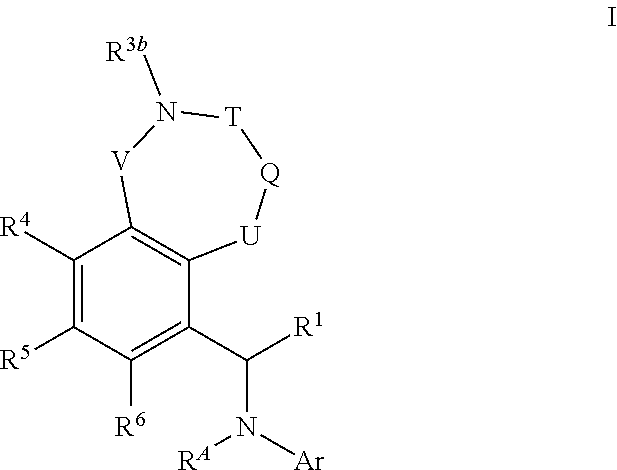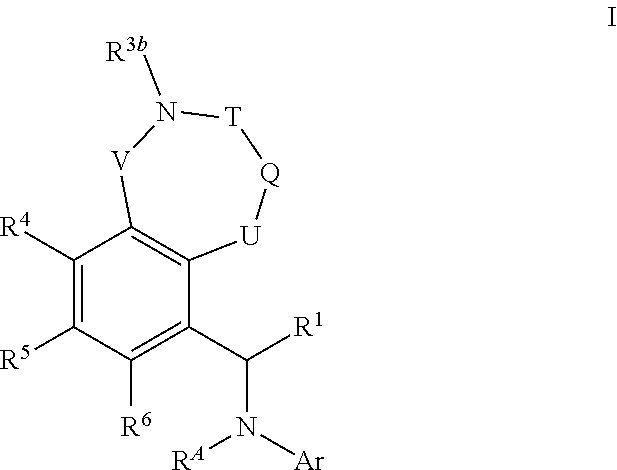Bicyclic azaheterocyclobenzylamines as PI3K inhibitors
a technology of azaheterocyclobenzylamine and inhibitor, which is applied in the field of azaheterocyclobenzylamine derivatives, can solve the problems of affecting and achieve the effect of improving the ability of b cells to activate t cells
- Summary
- Abstract
- Description
- Claims
- Application Information
AI Technical Summary
Benefits of technology
Problems solved by technology
Method used
Image
Examples
example 1
l 9-[1-(4-amino-3-methyl-1H-pyrazolo[3,4-d]pyrimidin-1-yl)ethyl]-7-chloro-6-methyl-2,3-dihydro-1,4-benzoxazepine-4(5H)-carboxylate
[0517]
Step 1. tert-Butyl [2-(6-acetyl-2-bromo-4-chloro-3-methylphenoxy)ethyl]carbamate
[0518]
[0519]A suspension of 1-(3-bromo-5-chloro-2-hydroxy-4-methylphenyl)ethanone (8.0 g, 30 mmol) in methylene chloride (304 mL) was heated with a heat gun to dissolve the solids and cooled to 0° C. To the mixture was added triphenylphosphine (11 g, 43 mmol) and tert-butyl (2-hydroxyethyl)carbamate (9.4 mL, 61 mmol). Diisopropyl azodicarboxylate (8.4 mL, 43 mmol) was added dropwise. The mixture was stirred for 23 hours at room temperature. The reaction mixture was poured into water and extracted with methylene chloride. The organic layer was separated, washed with brine, dried with sodium sulfate, filtered, and concentrated. The oil was dissolved in methylene chloride and was purified on silica using ethyl acetate in hexanes (0-25%) to give the desired compound (7.3 g, ...
example 2.1
Example 2. 1-[1-(7-Chloro-6-methyl-2,3,4,5-tetrahydro-1,4-benzoxazepin-9-yl)ethyl]-3-methyl-1H-pyrazolo[3,4-d]pyrimidin-4-amine bis(trifluoroacetate)
[0534]
[0535]tert-Butyl 9-[1-(4-amino-3-methyl-1H-pyrazolo[3,4-d]pyrimidin-1-yl)ethyl]-7-chloro-6-methyl-2,3-dihydro-1,4-benzoxazepine-4(5H)-carboxylate (10 mg, 0.02 mmol) was stirred in 4 N HCl in dioxane (1 mL), and then the solvent was evaporated. Purification by preparative LCMS (pH 2) gave the desired compound (1.8 mg, 7%). LCMS calculated for C18H22ClN6O (M+H)+: m / z=373.2; found: 373.1.
example 3
l 3-[9-[1-(4-amino-3-methyl-1H-pyrazolo[3,4-d]pyrimidin-1-yl)ethyl]-7-chloro-6-methyl-2,3-dihydro-1,4-benzoxazepin-4(5H)-yl]azetidine-1-carboxylate
[0536]
[0537]tert-Butyl 9-[1-(4-amino-3-methyl-1H-pyrazolo[3,4-d]pyrimidin-1-yl)ethyl]-7-chloro-6-methyl-2,3-dihydro-1,4-benzoxazepine-4(5H)-carboxylate (100 mg, 0.2 mmol) was treated with 4 N HCl in dioxane (1 mL), and then the solvent was evaporated. The residue was stirred in methanol (5 mL) and tert-butyl 3-oxoazetidine-1-carboxylate (140 mg, 0.84 mmol) was added. Sodium cyanoborohydride (120 mg, 1.9 mmol) was added and the mixture was warmed to 60° C. for 1.5 hours. Purification by preparative LCMS (pH 10) gave the desired compound (3.3 mg, 10%). LCMS calculated for C26H35ClN7O3 (M+H)+: m / z=528.2; found: 528.3. 1H NMR (300 MHz, CD3OD): δ 8.14 (s, 1H), 7.33 (s, 1H), 6.33 (m, 1H), 4.00 (m, 2H), 3.82 (m, 1H), 3.74 (m, 2H), 3.63 (m, 3H), 3.41 (m, 1H), 2.76 (m, 2H), 2.58 (s, 3H), 2.37 (s, 3H), 1.79 (m, 3H), 1.42 (s, 9H).
PUM
| Property | Measurement | Unit |
|---|---|---|
| Volume | aaaaa | aaaaa |
| Mass | aaaaa | aaaaa |
| Mass | aaaaa | aaaaa |
Abstract
Description
Claims
Application Information
 Login to View More
Login to View More - R&D
- Intellectual Property
- Life Sciences
- Materials
- Tech Scout
- Unparalleled Data Quality
- Higher Quality Content
- 60% Fewer Hallucinations
Browse by: Latest US Patents, China's latest patents, Technical Efficacy Thesaurus, Application Domain, Technology Topic, Popular Technical Reports.
© 2025 PatSnap. All rights reserved.Legal|Privacy policy|Modern Slavery Act Transparency Statement|Sitemap|About US| Contact US: help@patsnap.com



